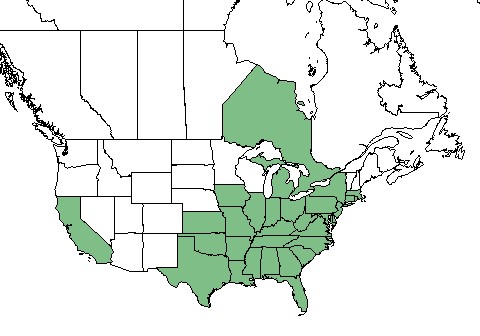Andropogon virginicus
| Andropogon virginicus | |
|---|---|

| |
| Photo by the Atlas of Florida Plants Database | |
| Scientific classification | |
| Kingdom: | Plantae |
| Division: | Magnoliophyta - Flowering plants |
| Class: | Liliopsida - Moncots |
| Order: | Cyperales |
| Family: | Poaceae |
| Genus: | Andropogon |
| Species: | A. virginicus |
| Binomial name | |
| Andropogon virginicus L | |

| |
| Natural range of Andropogon virginicus from USDA NRCS Plants Database. | |
Common Name(s): smooth bluestem, deceptive bluestem, old-field broomstraw, broomsedge, sedge grass, sage grass[1], broomsedge bluestem[2]
Contents
Taxonomic Notes
Varieties: A. virginicus var. virginicus; A. virginicus var. decipiens;[1][2] A. virginicus var. 1[1]
Description
Andropogon virginicus is a monoecious perennial graminoid.[2] It reaches 2-5 ft (0.61-1.52 m) in height and bunches together producing clumps (i.e. bunchgrass).[3]
Distribution
Its primary distribution ranges from eastern Texas, Oklahoma, and Kansas eastward to the coast of the Atlantic Ocean and as far north as Illinois, Michigan, New York, Massachusetts. It is also found in Puerto Rico, Ontario Canada, California, and was introduced in Hawaii.
Ecology
Habitat
Andropogon virginicus is commonly found in longleaf pine savannas, savannas, flatwoods, maritime wet grasslands, disturbed pinelands, other wetlands, old fields, roadbanks, and disturbed sites.[1] With such a wide range of habitats, A. virginicus has been shown to adapt to ecotones of varying water availability; in granite outcrops A. virginicus is more resistant to water loss than in old field habitat.[4]
Fire ecology
A review of early studies suggests A. virginicus can be nearly eliminated by fires.[5] However, more recent studies (reviewed in [6]) suggest A. virginicus is a pyrophyte that helps create a fire driven system by adding fuel to the fire and thereby promoting increases in fire frequency and size.[7] It maintains extremely high dead:live biomass ratios during most of the year at 80-90%. Additionally, it can burn at high relative humidity (85-90%) and fuel moisture (20-25%). When burned, it recovers quickly and with increased vigor.[8] Densities peak in the second growing season following burns.[9]
Use by animals
A. virginicus can encompass 2-5% of the diet for large mammals and terrestrial birds as well as occasionally being used as cover for terrestrial birds.[2]
Conservation and Management
A. virginicus is considered a noxious weed in Hawaii submontane zones[8] where it was introduced[2] and spread in the 1960's and 1970's.[7] Part of its successful invasion could be due to its ability to quickly invade disturbed lands, including those recently burned.[3]
Cultivation and restoration
Photo Gallery
References and notes
- ↑ 1.0 1.1 1.2 1.3 Weakley A. S.(2015). Flora of the Southern and Mid-Atlantic States. Chapel Hill, NC: University of North Carolina Herbarium.
- ↑ 2.0 2.1 2.2 2.3 2.4 USDA, NRCS. (2016). The PLANTS Database (http://plants.usda.gov, 30 November 2017). National Plant Data Team, Greensboro, NC 27401-4901 USA.
- ↑ 3.0 3.1 Plant database: Andropogon virginicus. (12 December 2017).Lady Bird Johnson Wildflower Center. URL: https://www.wildflower.org/plants/result.php?id_plant=ANVI2
- ↑ Chapman R. H. and Jones, Jr. S. B. (1975). Ecotypic differentiation in Andropogon virginicus (Gramineae). Bulletin of the Torrey Botanical Club 102(4):166-171.
- ↑ Garren K. H. (1943). Effects of fire on vegetation of the southeastern United States. Botanical Review 9(9):617-654.
- ↑ Hodgkins E. J. (1958). Effects of fire on undergrowth vegetation in upland southern pine forests. Ecology 39(1):36-46.
- ↑ 7.0 7.1 "Smith C. W. and Tunison J. T. (1992). Fire and alien plants in Hawai'i: Research and management implications for native ecosystems. Alien plant invasions in native ecosystems of Hawaii: management and research. Cooperative National Park Resources Studies Unit, Honolulu 394-408.
- ↑ 8.0 8.1 Hughes F., Vitousek P. M., and Tunison T. (1991). Alien grass invasion and fire in the seasonal submontane zone of Hawai'i. Ecology 72(2):743-747.
- ↑ Lemon P. C. (1949). Successional responses of herbs in the longleaf-slash pine forest after fire. Ecology 30(2):135-145.